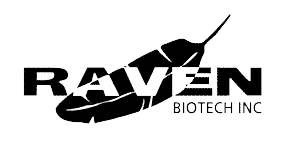
We may be able to save you some time and effort by sharing some of our experience in the production of recombinant proteins using the Pichia pastoris system. However, the rule is: “every product is different”. If it does not work for you, we at Raven Biotech Inc. assume no liabilities whatsoever.
Dissolved Oxygen
The high oxygen uptake rate (OUR) encountered during Pichia pastoris fermentation complicates the problem of controlling dissolved oxygen (pO2) . In fed batch cultures, it is usually necessary to supplement the air supply with pure oxygen to obtain the required OUR. Simple on/off gas sparging strategies do not provide satisfactory pO2 control. We use an automatic feedback control system that regulates the mixer agitation speed and the oxygen gas flow to the bioreactor, in order to maintain a set pO2 . The control strategy we usually use in fed batch fermentations is shown below:
Set Point
30% to 40% air saturation. We do not allow the dissolved oxygen to drop below 20% as this can result in the accumulation of toxic byproducts, e.g. formaldehyde.
Agitation
Agitation speed (rpm) = 300 min to 1000 max
.
Initial air sparge rate = 1 vvm.
Agitation will ramp from the minimum to the maximum rpm value as required to maintain the dissolved oxygen set point.
Rushton type impellers (minimum 2) should be positioned to give the maximum oxygen transfer rate (OTR) – contact us if you need help with this.
The upper impeller should be positioned slightly below the initial media level to avoid excess splashing during the feeding phase as fermentor volume increases. If this is not possible due to poor OTR, the upper impeller should be positioned such that splashing does not occur near the top of the fermentor.
Oxygen Supplementation
After maximum agitation speed has been reach, supplemental oxygen is required to maintain the dissolved oxygen set point. This can be accomplished by the use of a solenoid or mass flow controller, which is activated by the fermentor dissolved oxygen control system.
Initial oxygen sparge rate = 0.2 to 1.0 vvm.
CAUTION! Oxygen is hazardous, therefore consult your gas supplier for proper guidelines.
Exhaust Gas
Due to the long duration of the fermentation and high volumetric off gas rates, filters may become fouled or plugged, resulting in fermentor back pressure and poor dissolved oxygen control. This can be overcome by employing multiple back up filters in parallel as required.
Temperature
Set point
30C +/- C. Lower Temperatures (down to 20° C or less) may improve production if the product is unstable.
Cooling
Pichia pastoris fermentations generate appreciable amounts of heat during the course of fermentation. Fermentors fitted with a simple cooling finger may not offer sufficient cooling capacity, therefore a jacketed fermentor or a cooling coil fitted into the fermentor must be used to increase the cooling surface area.
Water temperature in warmer climates may not be cold enough for sufficient cooling, in which case a cooling recirculating water bath is required to maintain temperature.
Foam Control
Foaming can be controlled by an antifoam addition (i.e. Sigma antifoam 204) and/or mechanical foam breakers. Mechanical foam control is usually used in large scale systems.
Many benchtop fermentor systems are fitted with a conductance type probe into the fermentor headplate. As foam is generated during fermentation, contact occurs with the probe tip thereby activating an antifoam addition pump. False signals can be generated by condensation or residual foam on the probe tip resulting in excessive addition of antifoam.
When using a mixed feed strategy (i.e. glycerol plus methanol) antifoam can be added to the glycerol feed. We add antifoam to the initial medium, and then supply additional antifoam manually as required, or with a timer activated pump based on previous experience.
In latter stages of fermentation when foaming is most problematic, we reduce the agitation speed and airflow sparge rate and increase the supplemental oxygen flow if tolerable, to help reduce foaming.
pH Control
pH is usually controlled at pH 4.5 to 5.0. This normally requires the addition of base only. Ammonium hydroxide is the base of choice as it also servers as an alternate nitrogen source. The combined basal salt media and trace salts have a tendency to precipitate out of solution above pH 5.0, which interferes with cell density measurement and reduces salts available to the cells.
Off-line pH measurements should be done daily to ensure probe malfunction or drift has not occurred.
